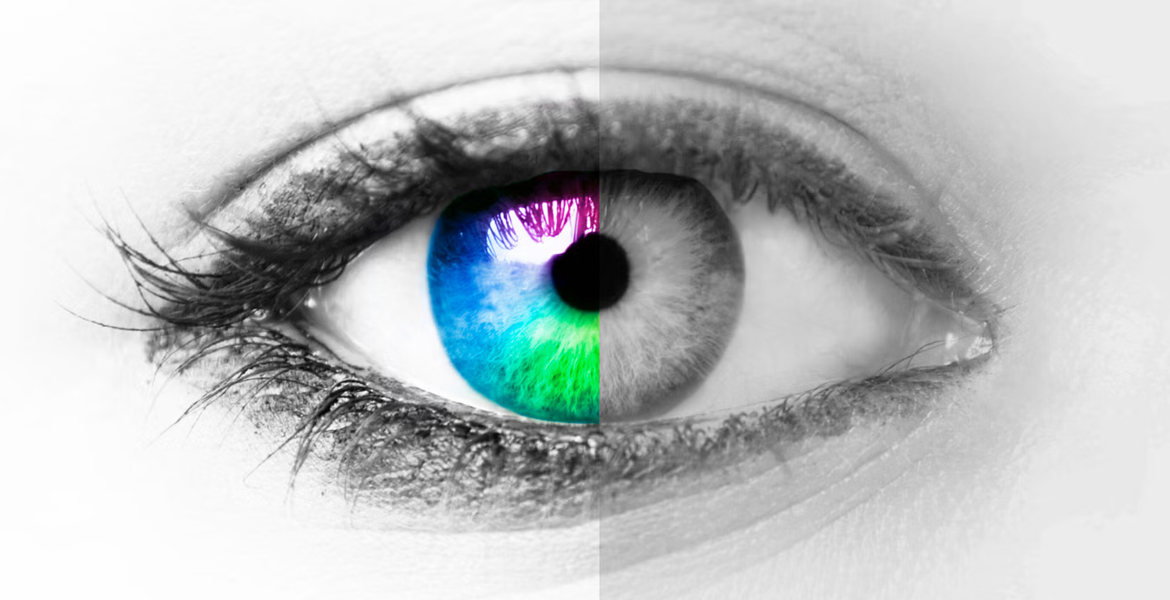Last updated: Tuesday, March 18, 2025
Colour plays a vital role in our perception, adding vibrancy and depth to our world. However, not everyone sees colours in the same way due to a condition called colour blindness, also known as colour vision deficiency. In this blog, we will explore the fascinating aspects of colour blindness, including its various types, underlying causes, and common symptoms experienced by individuals affected by this condition.
What is Color Blindness?
Colour blindness, also known as colour vision deficiency, is a common visual condition where individuals have different perceptions of colours. This happens because of irregularities in specialized nerve cells called cones, which are responsible for processing light and transmitting colour signals to the brain.
Despite the name, colour blindness doesn't mean not being able to see any colours at all. Most people with colour blindness can still see a range of colours, but they see certain colours differently compared to those with normal colour vision. This can make it challenging to distinguish between specific colours or shades and can affect the ability to assess the brightness of colours. International Color Blindness Awareness Month is a significant chance to exchange information and understanding about color blindness.
Types of Color Blindness
To grasp the different types of colour blindness, it is important to have a clear understanding of the role cones play in our eyes. Cones are specialized cells that detect colours within the visible spectrum of light. The visible spectrum includes wavelengths ranging from 380 nanometers (short) to 700 nanometers (long), and there are three types of cones responsible for detecting these colours:
- Red-sensing cones (L cones): Detect long wavelengths around 560 nanometers.
- Green-sensing cones (M cones): Detect middle wavelengths around 530 nanometers.
- Blue-sensing cones (S cones): Detect short wavelengths around 420 nanometers.
Based on cone functionality, colour blindness can be categorized as follows:
- Trichromacy: In this type, all three types of cones are present and functioning properly, allowing for normal full-colour vision.
- Anomalous Trichromacy: Here, all three types of cones are present, but one type is less sensitive to its corresponding wavelength. This results in varying degrees of colour perception abnormalities, ranging from mild to severe.
- Dichromacy: This type occurs when one type of cone is missing, leaving only two types of cones. As a result, it becomes difficult to distinguish between fully saturated colours.
- Monochromacy: In this category, either only one type of cone is present or none are functional. This severely limits the ability to perceive colours, causing the world to appear in shades of grey.
How Do Colorblind Glasses Work?
Colorblind glasses are designed to enhance the ability of individuals with color vision deficiencies to differentiate between colors more effectively. These glasses use special lenses that filter out specific wavelengths of light to improve the contrast between colors, making it easier for users to perceive them accurately. The lenses work by blocking certain light spectrums, which helps to highlight the colors that are typically hard to distinguish, such as red and green. While they don’t cure color blindness, they can help those affected by it see a broader range of colors in their everyday lives. read here for more information about how colorblind glasses work.
Causes of Color Blindness
Colour blindness is a condition that affects an individual's ability to accurately perceive certain colours. Various factors can contribute to the development of colour blindness, including genetic inheritance, environmental influences, and underlying medical conditions. Let's take a closer look at these causes.
1. Genetic Inheritance:
The most common cause of colour blindness is genetic inheritance, where the condition is passed down from parents to their children. Genetic mutations in the genes responsible for producing photopigments in the cone cells of the retina can lead to deficiencies in colour vision. These mutations disrupt the normal functioning of the cone cells, making it challenging for affected individuals to perceive specific colours accurately.
- X-Linked Recessive Inheritance: The most prevalent form of genetic colourblindness is red-green colour blindness, which follows an X-linked recessive inheritance pattern. This means that the genes responsible for normal colour vision are located on the X chromosome. In males, who have only one X chromosome, a single defective gene inherited from their mother can result in colour blindness. Females, on the other hand, typically require two defective genes, one from each parent, to experience colour blindness.
2. Diseases
Certain diseases and medical conditions can also lead to colour vision deficiencies. These conditions can affect the retina, optic nerve, or the visual processing centres in the brain.
- Eye Conditions: Diseases such as glaucoma, macular degeneration, and cataracts can impact the function of the retina and the optic nerve, leading to colour vision problems.
- Neurological Disorders: Medical conditions like Alzheimer's disease, multiple sclerosis (MS), and Parkinson's disease can affect the brain's ability to process visual information, resulting in colour vision deficits.
3. Medications and Chemical Exposure:
Exposure to certain chemicals and medications can alter colour vision by affecting the function of the retina or the visual processing centres in the brain.
- Chemicals: Exposure to chemicals in the workplace, such as organic solvents and heavy metals, can harm the nervous system and lead to colour vision impairments.
- Medications: Some medications, including those used to treat autoimmune diseases, heart problems, high blood pressure, erectile dysfunction, infections, and psychological disorders, can have side effects that impact colour vision.
4. Aging:
As individuals age, their ability to perceive colours can gradually decline. This is a natural part of the ageing process and is often accompanied by a decrease in the overall sensitivity of the retina.
5. Other Factors:
Other factors that may contribute to colour blindness include:
- Tobacco and Alcohol: The use of tobacco and excessive alcohol consumption has been associated with an increased risk of developing ccolourvision problems.
- Genetic Disorders: Besides inherited mutations, certain genetic disorders can also contribute to colour blindness.
Symptoms and Diagnosis
Recognizing these symptoms is important for accurate diagnosis and appropriate management. Here's an overview of the symptoms associated with colour blindness:
1. Difficulty Differentiating Colors:
People with colour blindness may have trouble distinguishing between certain colours or shades, such as confusing red and green, or blue and yellow.
2. Altered Perception of Brightness:
Some individuals with colour blindness might have challenges perceiving the brightness or intensity of certain colours.
3. Unawareness of Color Differences:
Many individuals with colourblindness are not aware of their condition, as they've always seen colours the same way.
4. Struggles with Educational Materials:
Children with colour blindness may encounter difficulties in educational settings that rely on colour-coded information.
5. Difficulty Identifying Color Shades:
Individuals with colour blindness, especially red-green or blue-yellow deficiencies, may have trouble distinguishing between shades of similar colours.
6. Achromatopsia (Severe Color Blindness):
In rare cases of severe colourblindness, known as achromatopsia, individuals are unable to perceive any colours at all and see the world only in shades of grey. This condition is often accompanied by other visual abnormalities, including rapid eye movement (nystagmus), sensitivity to bright light (photophobia), amblyopia (lazy eye), and poor vision.
7. Unusual Eye Movement and Sensitivity:
Individuals with severe colour blindness might exhibit rapid eye movement and sensitivity to bright light, which can impact their visual experience.
8. Challenges in Color Matching:
People with colour blindness may struggle with tasks that require matching or coordinating colours due to difficulty distinguishing subtle colour differences.
9. Noticeable Color Mismatch:
Often, colour blindness becomes apparent when others notice the affected person's challenges in accurately perceiving and identifying colours.
10. Gradual or Sudden Onset:
Color blindness can be present from birth (congenital) or develop later in life (acquired) due to various factors, such as genetics, diseases, or chemical exposures.
Wrapping up
Colour blindness is a common condition that alters how people perceive colours due to irregular cone functionality. While individuals with colour blindness can still see a range of colours, their perception differs from those with normal colour vision.
It is important to have an understanding of the different types, causes, and symptoms of colourblindness to identify it early and provide appropriate management. If you suspect that you or your child may have colour vision deficiency, it is crucial to consult an eye care provider for accurate assessment and support.

































